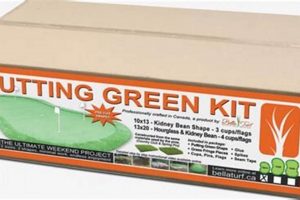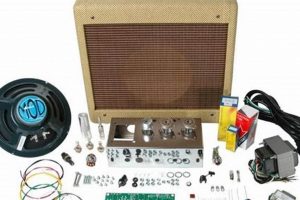Structures designed to shelter vehicles, and supplied as collections of pre-cut or pre-fabricated materials intended for assembly by the purchaser, are a common offering in the realm of outdoor building solutions. These packages typically include all necessary components, such as framing members, roofing panels, and hardware, along with detailed instructions to facilitate the construction process. As an example, a homeowner might purchase a package containing steel tubes, sheet metal roofing, and fasteners to erect a shelter for their automobile.
These solutions offer a cost-effective alternative to professionally installed structures, granting individuals the ability to customize their vehicle protection according to specific needs and site constraints. Historically, the desire for easily accessible and affordable shelters has driven the development of these pre-packaged systems, empowering individuals to improve their property with minimal reliance on external labor. The advantages extend beyond mere cost savings, encompassing the potential for increased property value and enhanced vehicle preservation.
The following sections will delve into the key considerations when evaluating these structural systems, including material selection, structural integrity, permit requirements, and the practical aspects of assembly. A comprehensive understanding of these factors is crucial for ensuring a successful and durable installation.
Essential Considerations for Self-Assembly Vehicle Shelters
The successful implementation of a self-assembled vehicle shelter hinges on careful planning and execution. Adhering to sound construction practices and understanding the nuances of each component is crucial.
Tip 1: Assess Local Building Codes: Prior to any purchase or construction, a thorough examination of local building codes and permit requirements is mandatory. Ignoring these regulations can lead to fines, mandated dismantling, or costly modifications to meet compliance standards.
Tip 2: Evaluate Site Conditions: A level and stable foundation is paramount. Assess the soil composition and drainage characteristics of the intended site. Addressing potential issues like uneven ground or water accumulation proactively will prevent structural instability and premature deterioration.
Tip 3: Select Appropriate Materials: Material selection should be dictated by climate and anticipated load. Steel offers superior strength and durability in areas prone to heavy snow or high winds. Aluminum provides corrosion resistance in coastal environments but may require additional bracing for structural integrity.
Tip 4: Adhere to Manufacturer Instructions: The assembly instructions provided by the manufacturer are not mere suggestions; they are meticulously engineered procedures designed to ensure the structural integrity and safety of the system. Deviating from these instructions can compromise the shelter’s ability to withstand environmental stresses.
Tip 5: Prioritize Safety Measures: Construction sites, even small ones, present inherent risks. Employ appropriate personal protective equipment, including safety glasses, gloves, and sturdy footwear. Utilize proper lifting techniques to prevent injury, and enlist assistance for handling heavy components.
Tip 6: Secure Anchoring: Proper anchoring is crucial for the stability of the entire structure. Ensure that the anchoring hardware is appropriate for the ground type and that it is installed according to the manufacturer’s specifications. Inspect anchors periodically, especially after significant weather events.
Tip 7: Regular Maintenance: Once assembled, regular inspection and maintenance are essential to maximize the lifespan of the structure. This includes cleaning debris from the roof, tightening loose fasteners, and addressing any signs of corrosion or damage promptly.
By diligently addressing these considerations, individuals can significantly increase the longevity, safety, and overall value of their self-assembled vehicle shelter.
The subsequent sections will explore potential modifications and enhancements to these structures, further optimizing their utility and integration into the surrounding environment.
1. Material Durability
Material durability is a paramount consideration when evaluating do-it-yourself vehicle shelter packages. The lifespan and resistance to environmental degradation of the chosen materials directly influence the long-term value and utility of the structure.
- Steel Framing and Corrosion Resistance
Steel, a common material for framing members, offers significant strength but is susceptible to corrosion. Galvanization, powder coating, or the use of weathering steel (e.g., Corten) are crucial for mitigating rust and ensuring longevity, especially in humid or coastal environments. The absence of proper corrosion protection can lead to structural weakening and eventual failure.
- Roofing Panel Composition and Weathering
Roofing panels are available in various materials, including steel, aluminum, and polycarbonate. Steel panels must possess protective coatings to prevent rust, while aluminum offers inherent corrosion resistance. Polycarbonate provides translucency but may degrade over time due to UV exposure, leading to discoloration and reduced impact resistance. Selection should align with expected weather conditions and desired lifespan.
- Fastener Quality and Compatibility
The type and quality of fasteners used to assemble the structure are frequently overlooked but critical to overall durability. Stainless steel or coated fasteners are essential to prevent galvanic corrosion when used with dissimilar metals like aluminum and steel. Inferior fasteners can corrode rapidly, weakening connections and compromising structural integrity.
- Impact of Environmental Factors
The environment to which the shelter is exposed significantly impacts material durability. Coastal regions necessitate corrosion-resistant materials, while areas with heavy snowfall demand structures designed to withstand substantial loads. High wind zones require robust anchoring systems and materials resistant to wind uplift. A thorough understanding of local environmental conditions is vital for selecting appropriate materials.
The interplay of these factors highlights the importance of carefully assessing material specifications before purchasing a vehicle shelter package. Neglecting material durability can result in premature failure, increased maintenance costs, and ultimately, a compromised investment. Considering the long-term implications of material choice is, therefore, an indispensable aspect of the decision-making process.
2. Structural Integrity
Structural integrity represents the capacity of a self-as
sembled vehicle shelter to withstand anticipated loads and environmental stressors without deformation or failure. Its significance is amplified in the context of do-it-yourself kits, where the quality of construction is heavily dependent on the assembler’s adherence to instructions and the inherent robustness of the design.
- Load Calculations and Design Specifications
DIY carport kits must be engineered to withstand specific load requirements, including snow accumulation, wind pressure, and the weight of the structure itself. Reputable manufacturers provide detailed load calculations and design specifications that comply with local building codes. The absence of these calculations or the use of inadequate specifications can result in structural collapse under adverse conditions. An example would be a structure failing under a heavy snowfall due to insufficient roof support.
- Connection Strength and Joint Stability
The strength of the connections between framing members is critical for maintaining structural integrity. Proper installation of fasteners, such as bolts and screws, is essential to prevent joint failure. Additionally, the design of the joints themselves must ensure stability and resistance to movement under load. A weak connection, such as improperly tightened bolts, can lead to progressive deformation and eventual structural failure. This could manifest as sagging or complete separation of structural members.
- Material Properties and Component Selection
The material properties of the components used in a DIY carport kit directly influence its structural integrity. Steel, aluminum, and wood each possess unique strength characteristics and resistance to environmental factors. The selection of appropriate materials, based on anticipated loads and environmental conditions, is crucial. For example, using thin-gauge steel in a high-wind area could compromise the structure’s ability to withstand wind forces, leading to damage or collapse.
- Foundation and Anchoring Systems
The foundation and anchoring system play a vital role in transferring the loads from the carport structure to the ground. Inadequate foundations or improper anchoring can lead to instability and failure. Soil conditions, frost depth, and wind uplift forces must be considered when designing the foundation and selecting appropriate anchoring methods. For instance, failing to properly anchor a carport in an area prone to strong winds could result in the entire structure being lifted and displaced.
The interplay between load calculations, connection strength, material properties, and foundation systems collectively determines the structural integrity of DIY vehicle shelters. Careful consideration of these factors, combined with diligent adherence to manufacturer’s instructions, is essential to ensure a safe and durable structure. Failure to address any of these aspects can compromise the entire system, potentially leading to costly repairs or catastrophic collapse.
3. Assembly Complexity
The assembly complexity of do-it-yourself vehicle shelter packages significantly impacts the feasibility and success of construction. A higher degree of assembly complexity can translate directly into increased construction time, a greater likelihood of errors, and the potential need for specialized tools or expertise. Inherent design flaws and poor instructions amplify these challenges. For example, a kit utilizing intricate joint systems or requiring precise alignment of numerous components demands a higher skill level and a greater time commitment from the assembler. Consequently, potential cost savings realized through self-assembly may be offset by the expenditure of time and the acquisition of specialized skills or tools.
The complexity of assembly also influences the structural integrity of the completed structure. Improperly executed connections or misaligned components, resulting from a complex assembly process, can compromise the shelter’s ability to withstand anticipated loads. A common issue arises when pre-drilled holes are misaligned or the instructions lack clarity, leading to improperly secured fasteners and weakened joints. This highlights the importance of detailed, unambiguous assembly instructions and a design that minimizes the potential for errors. Manufacturers often offer varying levels of assembly complexity, ranging from basic bolt-together systems to more intricate designs requiring specialized tools or welding. The choice should align with the assembler’s skill level and available resources.
Ultimately, understanding the assembly complexity of a self-assembled vehicle shelter package is essential for informed decision-making. Selecting a kit that matches the assembler’s capabilities and resources is crucial for a successful outcome. Neglecting this consideration can lead to frustration, delays, and a potentially compromised structure. Therefore, prospective purchasers should carefully review the assembly instructions, assess the required tools and skills, and realistically evaluate their ability to complete the project before committing to a specific do-it-yourself kit. A thorough evaluation of the assembly process is just as important as the material composition and structural design.
4. Permit Compliance
Permit compliance is a critical aspect of erecting do-it-yourself vehicle shelters. Many jurisdictions mandate permits for structures exceeding specific dimensions or altering existing property layouts. Neglecting to obtain necessary permits can lead to fines, legal action, and compulsory removal of the structure. For example, a homeowner who constructs a large vehicle shelter without proper authorization may face demands to dismantle the entire structure, incurring significant financial losses.
The relationship between building regulations and structural systems stems from the need to ensure public safety and adherence to established zoning laws. Building codes often dictate specific requirements for structural integrity, fire safety, and setbacks from property lines. Compliance with these codes necessitates detailed plan submissions, inspections, and adherence to prescribed construction standards. Consider the case of a steel shelter built in a high-wind zone. Building codes require the structure to withstand specific wind loads, impacting the anchoring system and material selection. Proof of compliance, demonstrated through engineering calculations and inspections, is typically required to secure a permit.
Ultimately, permit compliance represents a significant component of self-assembled construction projects. Failing to adequately research and address permit requirements can result in costly delays and legal repercussions. Thoroughly investigating local building codes and engaging with permit authorities is a crucial first step. The process provides assurance that the completed structure adheres to safety standards, contributing to long-term property value and minimizing the risk of future complications.
5. Cost-Effectiveness
The allure of self-assembly vehicle shelter packages frequently stems from the perception of reduced expenditures compared to professionally install
ed structures. The underlying cause is the elimination of labor costs, a significant component of construction projects. However, the true cost-effectiveness extends beyond the initial purchase price. Careful evaluation is essential to determine whether the projected savings are realized and whether the assembled structure provides long-term value. For example, a seemingly inexpensive package constructed with substandard materials may require frequent repairs or replacement, negating the initial savings. Therefore, material quality, structural design, and assembly considerations directly impact the ultimate economic benefit.
The importance of cost-effectiveness in the context of these packages lies in its influence on the overall return on investment. Selecting a durable, structurally sound, and easily assembled package maximizes long-term value, minimizing maintenance expenses and ensuring the shelter performs its intended function effectively. A real-life illustration is the comparison between two homeowners. One opts for the cheapest available package and incurs recurring repair costs due to material degradation, while the other invests in a slightly more expensive, higher-quality package that provides years of trouble-free service, thus achieving greater cost-effectiveness over time. The practical significance is that a superficial focus on initial cost can lead to a more expensive outcome in the long run.
In conclusion, the cost-effectiveness of do-it-yourself vehicle shelters is a multifaceted issue extending beyond the initial purchase price. Factors such as material durability, assembly complexity, and long-term maintenance play crucial roles. Careful consideration of these elements is imperative to achieve a truly cost-effective solution. Challenges arise in accurately predicting future maintenance costs and assessing the impact of assembly errors on structural integrity. Nonetheless, a holistic approach that weighs initial costs against long-term performance is essential for maximizing the economic benefits of self-assembled construction.
Frequently Asked Questions About DIY Carport Kits
The following questions address common inquiries regarding the selection, assembly, and maintenance of self-assembled vehicle shelters.
Question 1: What is the typical lifespan of a DIY carport kit?
The lifespan varies substantially, depending on the materials used, the quality of assembly, and the environmental conditions to which the structure is exposed. Steel structures with adequate corrosion protection can last several decades, while aluminum or less durable materials may have shorter lifespans. Regular maintenance, including cleaning and inspection, significantly prolongs the service life.
Question 2: Are specialized tools required for assembling a DIY carport kit?
The specific tools needed depend on the design and materials of the kit. However, common requirements include wrenches, sockets, drills, levels, and measuring tapes. Some kits may necessitate specialized tools such as crimpers or welding equipment. Reviewing the assembly instructions prior to purchase reveals the necessary tools.
Question 3: How does wind load affect the selection of a DIY carport kit?
Wind load is a critical factor, particularly in regions prone to high winds. Selecting a kit rated for the anticipated wind speeds in the area is essential. This rating should be clearly stated in the product specifications. Furthermore, proper anchoring of the structure is crucial for resisting wind uplift forces.
Question 4: Can a DIY carport kit be installed on any type of surface?
The suitability of the surface depends on the design of the kit and the bearing capacity of the soil. A level and stable foundation is generally required. Concrete slabs or properly compacted gravel pads are commonly used. Soft or unstable ground may necessitate additional support or ground preparation.
Question 5: What maintenance is required for a DIY carport kit?
Regular maintenance includes cleaning debris from the roof, inspecting for corrosion or damage, tightening loose fasteners, and ensuring proper drainage. Applying protective coatings or sealants can extend the lifespan of the materials. Addressing issues promptly prevents minor problems from escalating into major repairs.
Question 6: Are DIY carport kits customizable?
The degree of customization varies among kits. Some manufacturers offer options for adjusting dimensions, adding sidewalls, or selecting different roofing materials. However, modifications should be approached with caution, as they can affect the structural integrity and may violate building codes. Consulting with a structural engineer before undertaking significant modifications is advisable.
Thorough preparation and diligent execution are necessary when considering self-assembled structures. Proper construction guarantees not only structural integrity, but longevity and safety for vehicle and homeowner.
The subsequent discussion will address modification possibilities as well as potential for improving the integration with the environment.
DIY Carports Kits
The preceding examination of DIY carports kits underscores the multifaceted nature of these structures. A successful implementation necessitates careful consideration of material durability, structural integrity, assembly complexity, permit compliance, and cost-effectiveness. Neglecting any of these factors can compromise the safety, longevity, and overall value of the investment.
The decision to undertake a self-assembly project should be informed by a thorough assessment of individual skills, resources, and the specific requirements of the building site. Diligence in planning and execution is paramount, ensuring a structure that provides reliable vehicle protection while adhering to all applicable regulations. This commitment to quality yields enduring benefits and reflects responsible property stewardship.







